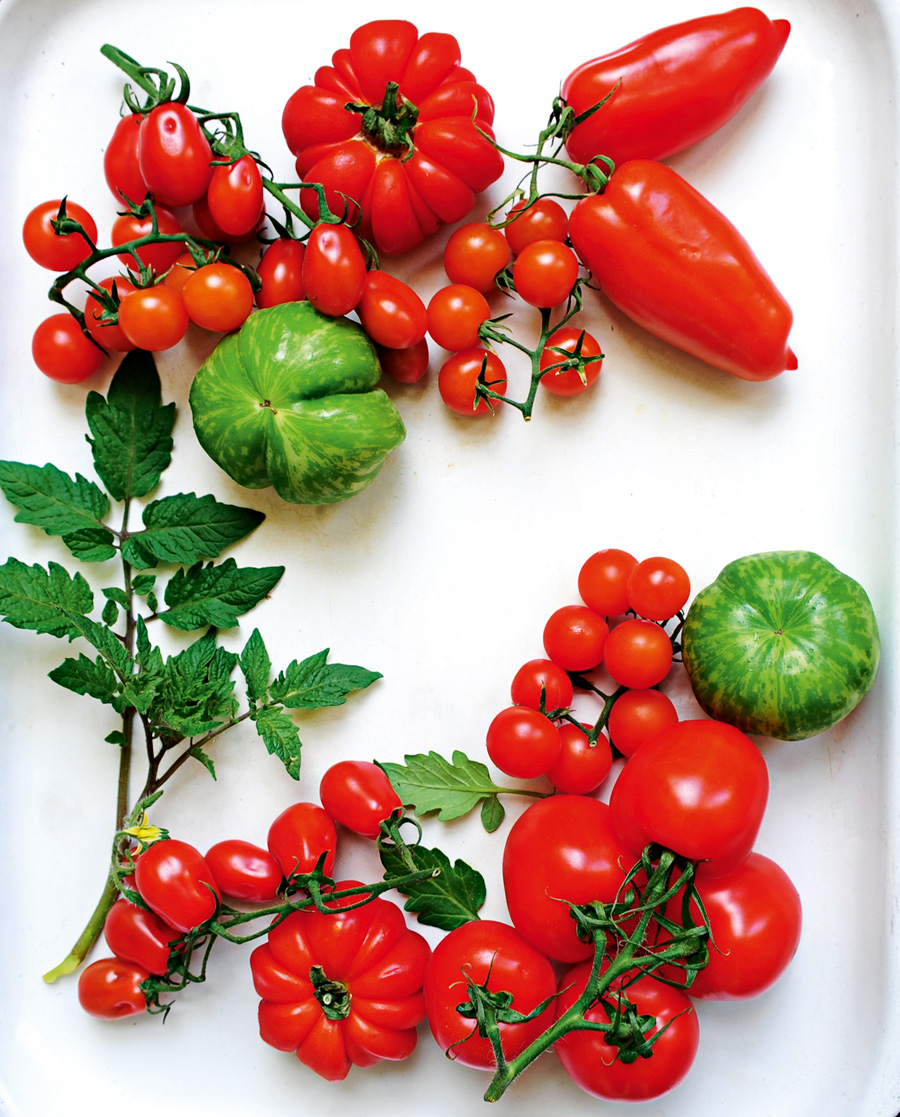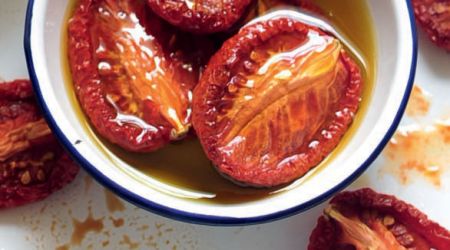Tomatoes
Striped, yellow, green or red; plum, round or pear-shaped; whatever colour or form they take, we British truly love our tomatoes, explains Michael Raffael with recipes by Linda Tubby
A couple of centuries ago, we called tomatoes ‘love apples’, a nod to the French pommes d’amour. The sexy name didn’t echo their status. The Gardener’s Encyclopedia (1825) damned them with faint praise: ‘When ripe, the fruit, which has an acid flavour, is put into soups, and the juice is preserved for winter use like ketchup; it is also used in confectionary, as a preserve; and when green, as a pickle’. The author added that compared to foreigners, especially Italians, we hadn’t a clue about handling them.
Over the next 150 years, tomatoes remained un-English. At best, we grilled them for breakfast and sliced them for sandwiches. In salads, we smothered them with onion or doused them with Worcestershire sauce. Then, in the 1970s, we discovered pizza and spaghetti and the carmine sauces that adorn them.
Everything changed, except our native crop. If we wanted homemade salsa pomodoro we had to rely on cans and a squirt of purée from a tube. The regimented tomatoes ripened in our greenhouses wouldn’t produce a sauce that glowed with the Mediterranean sunshine we enjoyed on our trips to Cannes, Florence and the Costa del Sol.
Fast forward to the present. Name any kind of tomato, from moneymaker to gardener’s delight, and we grow it. Hydroponic monocultural varieties, drip-fed under acres of glass, stoke supermarket shelves. Meanwhile, enthusiasts nurture green zebra, white cherry or brandy wine in greenhouses and grow bags. Big, little, on or off the vine, bright red, golden yellow, striped, plum or pear-shaped, tasty or tasteless, it’s out there. Comparing both ends of the spectrum is like measuring a Cox’s orange pippin against a Bramley: same species, very different beasts.
Greengrocers sell grapes by the bunch. They market vine-ripened tomatoes by the ‘truss’. Selling seven perfectly matched, ready-to-eat fruits attached to one stalk would never occur to a Sicilian farmer. Does our home-grown produce stack up against a field of, say, San Marzano or Marmandes? The answer, according to Michael Michaud, is ‘you’re not comparing like with like’.
Michael experiments with tomato varieties on his Dorset farm, collecting seeds from around the world and keeping tasting notes: ‘I think we should get over the romantic idea that outdoors is better,’ he says. ‘Overall, our quality has improved significantly.’
It’s a position he qualifies by adding that tomatoes develop more flavour when stressed. Controlled conditions guaranteed by agribusiness can’t replicate Mediterranean sunshine.
What interests people more, he suggests, is the balance of sweet and sour, the thickness of the skin, the amount of jelly in which the seeds are suspended, the fleshiness and ripeness. Heritage/heirloom cultivars may not be tastier than newer kinds. Terroir plays its part. Alicante, much loved by amateurs, can be delicious. It can also turn out disappointing, affected by weather or poor soil. Eye-appeal, Michael says, plays a part: ‘I had Slow Food round last summer and they said flattering things about my green zebra. When I looked at my own tasting notes afterwards I’d described it as quite bland.’
Some rules of thumb hold good. Beef tomatoes have more flesh; they tend to be less acid. Cherry tomatoes are sweeter. Elongated plum tomatoes seem to suit cooking better than other kinds.
In salads and when cooked, tomatoes have a natural affinity with basil, oregano and olive oil, and also tarragon. Diced shallots, incidentally, add bite to a classic tomato vinaigrette. The partnership with cucumbers isn’t just an English aberration. It occurs in Greek, Turkish and Arabic salads, the latter seasoned
with mint and lemon juice.
One reason why supermarkets have had problems with tomatoes is that they don’t like being chilled, and this has major implications for storage, distribution and shelf-life. At home, don’t keep them in the fridge because it will turn the flesh woolly and nullify the aroma. Without any other clues, the freshly picked scent is a good guide to buying. If it doesn’t smell good, it’s not going to taste good.
There are tricks for perking up otherwise modest produce. Seasoning with salt or a pinch of sugar a few minutes before serving seems to extract more flavour. Blending a star-shaped peduncle (the green stalk of the tomato) with the dressing lifts a tomato soup or juice.
Glutamate occurs naturally in tomatoes – and not just as a trace element. Long, slow cooking concentrates the compound and intensifies the flavour. It’s the secret behind sun-dried tomatoes’ success.
The window when home-grown tomatoes should be in season is short, from mid-summer to early autumn. In practice, we stretch it out from early spring to the end of October. Too often we make do with tomatoes that have lost their freshness and aroma.
It may have taken 200 years, but we’ve learnt a lot about how to grow and cook with this vegetable-fruit. If we had the discipline to use the tomato only when it’s at its best and in season, I reckon we could give those Mediterranean cooks a run for their money.

Recipes
Get Premium access to all the latest content online
Subscribe and view full print editions online... Subscribe



